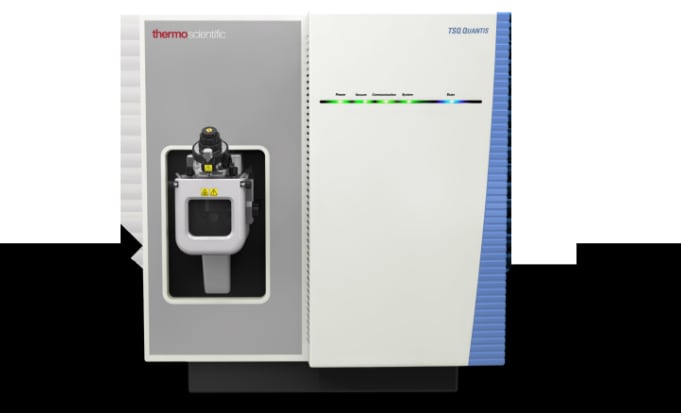The Quantis Triple Stage Quadrupole (TSQ) mass spectrometer is a mid-range quantitative workhorse instrument designed to support reliable workflows with the sensitivity and precision users require and be simple to use and easy to maintain.
The TSQ Altis is a high-end mass spectrometer which offers sensitivity, selectivity and speed with the analytical flexibility and reproducibility for demanding applications and complex matrices.
TSQ Altis and TSQ Quantis replace the previous generation TSQ Quantiva and TSQ Endura, respectively.
Matrices, analytes and regulatory requirements
Dr Debadeep Bhattacharyya, senior manager of product marketing (Triple Quadrupole MS) for the applied market division at Thermo Fisher Scientific, said needs for targeted quantitation are evolving with increasingly complex matrices, complicated analytes and changing regulatory requirements.

“Labs performing targeted quantitation require a complete workflow solution that will not only offer optimal platforms for every step of the workflow but would also offer superior data quality with a robust, sensitive and reproducible quantitation assay,” he said.
“Triple quadrupoles are extremely popular and widely accepted as the chosen technology for quantitation assays. While it can be considered as an established technology in a saturated market, the challenges in developing robust, reproducible quantitation assays continue to grow.
“There is a constant requirement to achieve higher sensitivity with increased robustness, addressing regulatory requirements, and reduce cost/sample – above everything, achieve quality results faster than ever before.”
LC-MS based workflows are used for qualitative and quantitative (targeted and untargeted quantitation assays) analyses due to superior selectivity, specificity, sensitivity and ease-of-use that mean the user can get high quality data confidently for every molecule(s) in complex matrices.
“From achieving LLOQs ranging from sub-pg/mL to ng/mL (or ppt to ppm), from high resolution capabilities in mass spectrometer to confidently identify and confirm every analyte signal in a mixture, mass spectrometers offer an easy-to-implement solution for critical challenges faced in every analytical laboratory,” said Dr Bhattacharyya.
The systems are engineered to deliver high-resolution single reaction monitoring (SRM) capabilities which enables ion transmission and consistency for reproducible results across instruments.
They are equipped with Active Ion Management (AIM+) technology that includes redesigned ion source housing, segmented quadrupoles, new RF electronics and an enhanced dual-mode electron multiplier detector for ion management from ion inception to detection.
AIM+ technology offers more data points with fast SRM rates and increased detector lifetime compared to previous AIM technology and other triple quadrupole mass spectrometry systems.
Targeted or untargeted?
Dr Bhattacharyya said there is a strong demand for targeted and untargeted analysis and quantitation.
“While untargeted analysis and quantitation offer superior confidence in ensuring product quality, targeted quantitation offers higher speed and sensitivity to identify and quantify every known analyte in a mixture. The optimal approach depends on the applications and requirements of each lab,” he said.
“Labs performing compliance testing, for example, will need to perform targeted analysis for a very specific compound list, and would also expect faster turnaround of results. So for such applications, targeted analysis is a much better option.
“However, for applications where labs need to search for unknowns and identify those unknowns, for example when looking for potential resides and contaminants, high resolution-accurate mass (HRAM) spectrometry could be the favoured option as it allows identification of targeted analytes, as well as non-targeted screening.”
Evett Kruka, VP and general manager, life sciences mass spectrometry, chromatography and mass spectrometry at Thermo Fisher, said labs are under increasing pressure to answer complex analytical questions, while still meeting regulatory, business and scientific goals.
"Our newest generation of triple quadrupole mass spectrometers is designed to deliver reproducible, reliable quantitation results for nearly all molecule types in complex matrices, even by less experienced users.”
